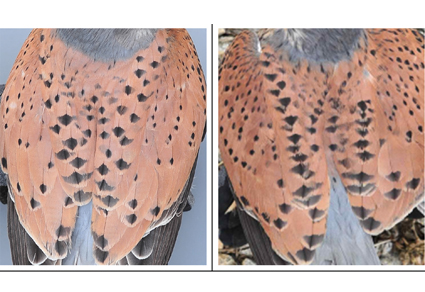Abstract
Zhang et al. (2008) investigated subspecific variation of Common Kestrels (Falco tinnunculus) wintering in Beijing, China, using a partial mtDNA control region (394–395bp), and concluded that two subspecies were present. However, analysis of their raw data revealed mostly double peaks at each nucleotide position, indicating ambiguity in the DNA sequence. These likely arose from a combination of factors, including irregular PCR efficiencies and slight primer mismatches. Zhang et al. (2008) likely misinterpreted these double peaks as evidence of distinct subspecies. This resulted in an inflated number (56) of variation sites. Their interpretation was further confounded by potential issues with their primers, designed from a sequence of F. peregrinus with a one-nucleotide difference. To address these limitations, we sequenced the full mtDNA control region (1,266bp) of 38 Common Kestrel samples using newly designed primers. This analysis yielded clean, single-peak profiles for each sequence, confirming that all samples belonged to F. t. interstinctus. We therefore propose reclassifying these populations as a single subspecies, F. t. interstinctus. Erroneous barcode sequences can distort subspecific identification and population structure, leading to inaccurate data and misleading phylogenetic inferences. Our study underscores the critical need for robust methods to minimize barcode sequencing errors. This would not only ensure accurate phylogenetic inferences for Common Kestrels but also support reliable population genetic studies across diverse taxa.
References
- Abd-Elsalam, K.A. (2003) Bioinformatic tools and guideline for PCR primer design. African Journal of Biotechnology, 2 (5), 91–95. https://doi.org/10.5897/AJB2003.000-1019
- Austin, O.L. (1948) The Birds of Korea. Bulletin of the Museum of Comparative Zoology at Harvard College, 101 (1), 301.
- Boev, Z. (1999) Falco bakalovi sp. n.—a Late Pliocene falcon (Falconidae, Aves) from Varshets (W Bulgaria). Geologica Balcanica, 29 (1/2), 131–135. https://doi.org/10.52321/GeolBalc.29.1-2.131
- Boev, Z. (2011) Falco bulgaricus sp. n. (Aves: Falconiformes) from the Late Miocene of Hadzhidimovo (SW Bulgaria). Acta Zoologica Bulgarica, 63, 17–35.
- Boyce, D.A. & White, C.M. (1987) Evolutionary aspects of kestrel systematics: A scenario. In: Bird, D.M. & Bowman, R. (Eds.), The Ancestral Kestrel. Raptor Research Report, 6, pp. 1–21.
- Clark, A.H. (1907) Eighteen new species and one new genus of birds from eastern Asia and the Aleutian islands. Proceedings of the United States National Museum, 32 (1539), 467–475. https://doi.org/10.5479/si.00963801.32-1539.467
- Clark, A.H. (1910) Report on a collection of birds made by Pierre Louis Jouy in Korea. Proceedings of the United States National Museum, 38 (1735), 147–176. https://doi.org/10.5479/si.00963801.38-1735.147
- Clements, J.F. (2007) n.k. In: Clements Checklist of Birds of the World. 6th Edition. Cornell University Press, Ithaca, New York, pp. 50–51.
- Meise, W. (1934) Die Vogelwelt der Mandschurei. Abhandlungen und Berichte der Museums für Tierkunde und Völkerkunde zu Dresden, 18 (2), 1–86.
- Costantini, D. & Dell’Omo, G. (2020) The Kestrel. Cambridge University Press, Cambridge, 17 pp.
- Crossley, B.M., Bai, J., Glaser, A., Maes, R., Porter, E., Killian, M.L., Clement, T. & Toohey-Kurth, K. (2020) Guidelines for Sanger sequencing and molecular assay monitoring. Journal of Veterinary Diagnostic Investigation, 32 (6), 767–775. https://doi.org/10.1177/1040638720905833
- Ferguson-Lees, J. & Christie, D.A. (2001) n.k. In: Raptors of the World. Houghton Mifflin, Boston, Massachusetts, pp. 274–275.
- Fuchs, J., Johnson, J.A. & Mindell, D.P. (2015) Rapid diversification of falcons (Aves: Falconidae) due to expansion of open habitats in the Late Miocene. Molecular Phylogenetics and Evolution, 82, 166–182. https://doi.org/10.1016/j.ympev.2014.08.010
- Gill, F. & Donsker, D. (2014) IOC World Bird List. Version 4.2. Available from: https://www.worldbirdnames.org/ioc-lists/crossref/ (accessed 9 June 2025) https://doi.org/10.14344/IOC.ML.4.2
- Groombridge, J.J., Jones, C.G., Bayes, M.K., van Zyl, A.J., Carrillo, J., Nichols, R.A. & Bruford, M.W. (2002) A molecular phylogeny of African kestrels with reference to divergence across the Indian Ocean. Molecular Phylogenetics and Evolution, 25 (2), 267–277. https://doi.org/10.1016/S1055-7903(02)00254-3
- Lee, J.H., Ryu, S.H. & Park, H.C. (2006) Mitochondrial cytochrome b gene of the Korean subspecies of the Common Kestrel (Falco tinnunculus). Animal Systematics, Evolution and Diversity, 22 (1), 87–89.
- Park, J.G. (2022) n.k. In: Identification Guide to Birds of Korea. Checklist of Organisms in Korea. Series 12. Revised 2nd Edition. Nature and Ecology Publication, Seoul, pp. 150–151. [in Korean]
- Park, J.G., Seong, J.W., Kim, E.J., Park, C. & Nam, D.H. (2022) Taxonomic study of Common Kestrel (Falco tinnunculus) in Korea. Korean Journal of Ornithology, 29 (2), 95–104. https://doi.org/10.30980/KJO.2022.12.29.2.95
- Svensson, L. (1992) Identification Guide to European Passerines. Published by author, Stockholm, pp. 11–30.
- Vaurie, C. (1961) Systematic notes on Palearctic birds, no. 45, Falconidae: the genus Falco (part 2). American Museum Novitates, 2038, 1–24.
- Vaurie, C. (1965) The Birds of the Palaearctic Fauna: Non-Passeriformes. Witherby, London, 763 pp.
- Village, A. (2010) The Kestrel. Bloomsbury, London, pp. 17–46.
- Wenink, P.W., Baker, A.J. & Tilanus, M.G. (1993) Hypervariable-control-region sequences reveal global population structuring in a long-distance migrant shorebird, the Dunlin (Calidris alpina). Proceedings of the National Academy of Sciences, 90 (1), 94–98. https://doi.org/10.1073/pnas.90.1.94
- Yamashina, Y. (1932) On the specimens of Korean birds, collected by Mr. Hyojiro Orii. Japanese Journal of Ornithology, 7 (33–34), 213–252. https://doi.org/10.3838/jjo.7.33-34_213
- Zhang, L., Liu, Y. & Song, J. (2008) Genetic variation between subspecies of Common Kestrels (Falco tinnunculus) in Beijing, China. Journal of Raptor Research, 42 (3), 214–219. https://doi.org/10.3356/JRR-07-18.1


